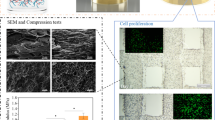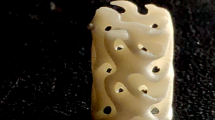Abstract
In order to obtain biocompatible carriers with mechanical properties close to living tissues, 3D-printing was carried out on a modified 3D-printer created on the basis of the Wanhao Duplicator 4S (China) by installing a special extrusion head - a syringe extruder for the possibility of printing sodium alginate and chitosan hydrogels. The optimal compositions of hydrogels for 3D-printing using “supporting” hydrogels based on agar or gelatin, which allow forming print objects, have been determined. Stable structures were obtained in the form of a Menger cube with a satisfactory shape and size. Optimal speeds of movement of the extruder-syringe for 3D-printing with sodium alginate hydrogel into agar “supporting” gel – 9–11 mm/s, for sodium alginate into gelatinous “supporting” gel – 2 mm/s, for chitosan into “supporting” gel with the addition of (NH4)2HPO4 – 6–8 mm/s.
Access this chapter
Tax calculation will be finalised at checkout
Purchases are for personal use only
Similar content being viewed by others
References
Wang, J., Lu, T., Yang, M., Sun, D., Xia, Y., Wang, T.: Hydrogel 3D printing with the capacitor edge effect. Sci. Adv. 5, eaau8769 (2019)
Williams, A.H., Roh, S., Jacob, A.R., Stoyanov, S.D., Hsiao L., Velev, O.D.: Printable homocomposite hydrogels with synergistically reinforced molecular-colloidal networks. Nat. Commun. 14, 283 (2021)
Han, D., et al.: Soft robotic manipulation and locomotion with a 3d printed electroactive hydrogel. ACS Appl. Mater. Interfaces 10(21), 17512–17518 (2018)
Taylor, D., O’Mara, N., Ryan, E., Takaza, M., Simms, C.: The fracture toughness of soft tissues. J. Mech. Behav. Biomed. Mater. 6, 139–147 (2012)
Lin, S., Liu, Ji., Liu, X., Zhao, X.: Muscle-like fatigue-resistant hydrogels by mechanical training. Proc. Nat. Acad. Sci. 116(21), 10244–10249 (2019)
Dekopov, A.V., Tomskiy, A.A., Artyukhov, A.A., Mnikhovich, M.V., Paskhin, D.L., Salova, E.M.: Method for microscurgeric reconstruction of the spinal cord on an animal model by using polyvinyl alcohol biodegradated hydrogel. Application filed by Federal State Autonomous Institution “National Medical Research Center of Neurosurgery named after Academician N.N.Burdenko” of the Ministry of Health of the Russian Federation (FSAU “NMIC of Neurosurgery named after Academician N.N.Burdenko” Ministry of Health of Russia Date of publication: 08.02.2018 Bull. № 4. Priority to RU2016150195A, Application granted 2018-02-08
Hong, S., et al.: 3D printing of highly stretchable and tough hydrogels into complex, cellularized structures. Adv. Mater. 27(27), 4035–4040 (2015)
Foley, P.L., et al.: A chitosan thermogel for delivery of ropivacaine in regional musculoskeletal anesthesia. J. Biomater. 34, 2539–2546 (2013)
Dovydenko, Y.M., Agabekov, V.Y., Chizhik, S.A.: Optimization of 3D printing parameters with sodium alginate hydrogel. Proc. Nat. Acad. Sci. Belarus. Phys. Tech. Ser. 64(1), 7–13 (2019)
Hinton, T.J., et al.: Three-dimensional printing of complex biological structures by freeform reversible embedding of suspended hydrogels. Sci. Adv. 1(9), e1500758 (2015). https://doi.org/10.1126/sciadv.1500758
Author information
Authors and Affiliations
Editor information
Editors and Affiliations
Rights and permissions
Copyright information
© 2022 The Author(s), under exclusive license to Springer Nature Singapore Pte Ltd.
About this paper
Cite this paper
Avdeeva, E.V., Dovydenko, Y.M., Laznev, K.V., Petkevich, A.V., Rogachev, A.A., Agabekov, V.E. (2022). Application of Additive Technology to Create Universal Carriers of Cellular Structures. In: Khakhomov, S., Semchenko, I., Demidenko, O., Kovalenko, D. (eds) Research and Education: Traditions and Innovations. INTER-ACADEMIA 2021. Lecture Notes in Networks and Systems, vol 422. Springer, Singapore. https://doi.org/10.1007/978-981-19-0379-3_3
Download citation
DOI: https://doi.org/10.1007/978-981-19-0379-3_3
Published:
Publisher Name: Springer, Singapore
Print ISBN: 978-981-19-0378-6
Online ISBN: 978-981-19-0379-3
eBook Packages: Intelligent Technologies and RoboticsIntelligent Technologies and Robotics (R0)




